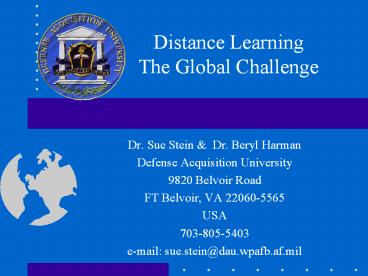Distance Learning The Global Challenge - PowerPoint PPT Presentation
1 / 33
Title:
Distance Learning The Global Challenge
Description:
All except New Zealand are using Distance Learning to deliver some training ... UK and Australia focused more on low tech distance learning ... – PowerPoint PPT presentation
Number of Views:428
Avg rating:3.0/5.0
Title: Distance Learning The Global Challenge
1
Distance LearningThe Global Challenge
- Dr. Sue Stein Dr. Beryl Harman
- Defense Acquisition University
- 9820 Belvoir Road
- FT Belvoir, VA 22060-5565
- USA
- 703-805-5403
- e-mail sue.stein_at_dau.wpafb.af.mil
2
In This Session
- The Defense Acquisition University
- The USA ARC
- USA ARCs Findings to Date
- Lessons Learned from Experience
- Challenges and Direction for the Future
3
About Defense Acquisition University
- Established in 1992
- Mission - To train and certify the DoD
Acquisition Workforce (180K) - Audience - Military civilians at all levels
- Scope - 81 courses covering 11 major career
fields - Faculty- 550 instructors and educators
4
The Call to US Government
- Enhance learning and education through
technology- www.pub.whitehouse.gov - Use of information technology to improve our
society-www.pub.whitehouse.gov
5
Our Strategy
- All DAU courses will be reviewed for conversion
to distributed learning within the next five
years. - Those courses or course segments appropriate for
distributed learning will be converted using
contracted support.
6
USA Acquisition Research Committee
- Founded in 1998
- Group of USA Civilians Military engaged in
training acquisition staff - Mission - To research acquisition workforce
related training issues
7
USA ARC Study
- What is the status of distance learning as a
vehicle for training the federal workforce in
select countries?
8
Preparing for the Study
- Design of the methodology.
- Endorsement by key officials.
9
USA ARC Study Findings
- Population Demographics
- Training Environment
- Use of Distance Learning Technology
- Challenges for Future Collaboration
10
Findings on Population
- Similar categories of staff involved
- Size of the population varied
- Education level average highest in
- Australia
- Experience level average lowest in
- Australia
11
Acquisition Specialties
Australia
Canada
Israel
New Zealand
United Kingdom
United States
12
Size of Acquisition Work Force
13
Levels of Education
14
Experience Levels
15
Findings on Training Environment
- Varied sources for training support
- Most had certification requirements
- Average of 120 hours of education provided
annually - Only two countries had mandatory continuing
education requirements
16
Sources Utilized for Training
17
Workforce Training Requirements
18
Findings on Percentage of Distance Learning
- All except New Zealand are using Distance
Learning to deliver some training - of training provided by distance learning is
less 20 of all training - UK and Australia focused more on low tech
distance learning - US and Canada focused more on high tech distance
learning
19
Percentage of Distance Learning from Different
Methods
20
Findings on Distance Learning
- The USA reported the greatest variety of
categories of training offered - The USA reported the greatest variety of support
mechanisms - Australia reported the greatest incidence of
challenges to implementation followed by Canada
and the USA
21
Categories of Training
22
Support for Acquisition Training
23
Challenges to Implementation
24
Lessons for Global Collaboration
- Areas for collaboration are systematically
identified - Contacts are current and electronic
- Management is supportive of the effort
- Technology interface issues are resolved
- Time zone, cultural, and religious challenges are
accommodated - Equipment inadequacies
25
Questions?
26
Our DAU Virtual Campus
27
(No Transcript)
28
Our Global Challenge to YOU!!
What YOU ARE INVITED TO PARTICIPATE IN A GLOBAL
DIALOGUE USING DISTANCE LEARNING. When JANUARY
2001 Where THE INTERNET USING CENTRA
COLLABORATIVE SYSTEMS
29
Installing Centra 99
Go to http//192.239.92.194
Click on Install (hot-word)
30
Centra 99 Log In
31
Enroll and Attend A Class
32
Participants Desktop
33
THANK YOU
FOR INVITING US TO PARTICIPATE IN YOUR CONFERENCE































